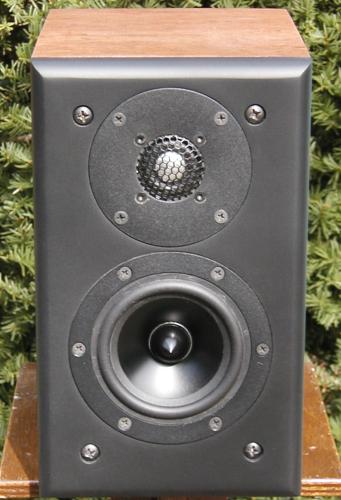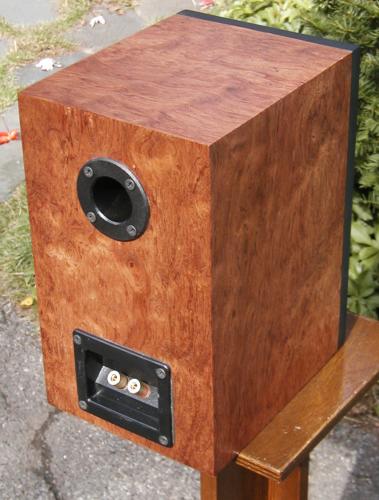
 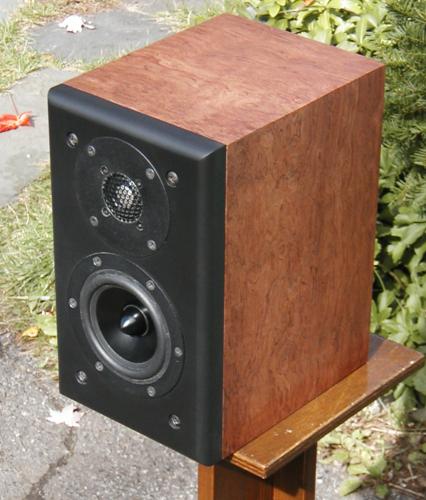 IntroductionThe Microbe SE (Special Edition) is identical to the original Microbe except I substituted in the Seas 22TAF/G metal dome tweeter. It still uses the Dayton RS125S-8 5" aluminum woofer and the same woofer filter except the woofer is located slightly lower on the baffle to make room for the larger flange of the 22TAF/G. I tuned the crossover to provide a frequency response that is very similar to the orignal design but with less of a BBC dip in the midrange. The result is a more detailed, more neutral, more analytical version of the Microbe. This is basically the audiophile version of the Microbe because it is a bit more accurate and a little less musical. If you only listen to rock music then I think the original Microbe is a better choice but if you also listen to jazz and classical then the Microbe SE is recommended.DriversSeas 22TAF/G Alum./Magn. 22mm dome tweeter The 22TAF/G is a High Definition metal dome tweeter with wide, coated fabric surround. The relatively small voice coil diameter and the wide surround combine the high frequency behaviour of a ¾" dome with the low frequency characteristics of a 1" dome. A large ferrite magnet gives high efficiency. The dome is precision formed from an aluminum/magnesium alloy for low mass and high rigidity and stability. The precoated surround material gives high consistency and excellent stability against variations in air humidity. An acoustically open Hexagrid protects the dome diaphragm. The voice coil is wound on an aluminum coil former with adequate venting holes to eliminate noise from internal air flow. The coil is immersed in a low viscosity magnetic fluid for high power handling capacity and simplified crossover design. The chassis is moulded from a stiff and stable glass fibre reinforced polymer material, and its front design offers optimum radiation conditions.Dayton RS125S-8 Reference Series 5" shielded aluminum woofer The Dayton Reference Series sets a new standard of value in high-performance loudspeaker drivers. Utilizing a low-distortion motor system with two short-circuit paths and a rigid aluminum cone, the Reference Series can outperform drivers that cost several times the price. Their low-distortion characteristics and high excursion capabilities provide exceptional clarity, detail, and dynamics. Woofers feature a shielded motor system, black anodized cone, heavy-duty 6-hole cast frame, low-loss rubber surround, and solid aluminum phase plug. Cabinet DesignThe cabinet for the Microbe SE is identical to the original Microbe cabinet except the driver locations and cutouts are different on the baffle. Refer the the Microbe "Cabinet Design" section for more details on the construction but I'll summarize here. The cabinet design is shown below. The entire cabinet is made from 3/4" MDF but you could use hardwood for the front baffle if you want. The front baffle is removable and is held on using 4 bolts/T-nuts that I got from Parts Express. The cabinet is lined with 1/2" Sonic Barrier foam on all walls except the baffle. Using Sonic Barrier on the inside back panel is optional because the port and crossover take up most of the space. I chose not to use fill at all. Both drivers should be flush mounted and an easy way to do this without using a router is to use a piece of 1/8" Masonite on the front baffle to create a "frame" around the drivers. The crossover can be screwed to the back of the cabinet just below the port.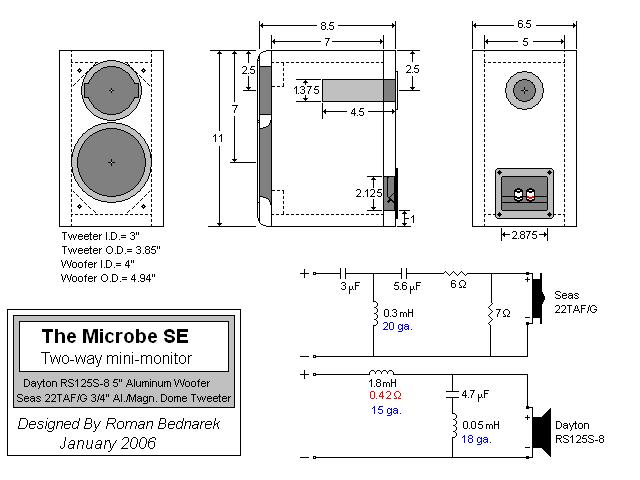
Crossover DesignThe Microbe SE crossover is shown above. The woofer filter is identical to that of the original Microbe. The tweeter filter was modified to accept the Seas 22TAF/G tweeter and provide a similar response to that of the original Microbe except with a little less of a dip in the crossover region. I used Jantzen air core inductors, Dayton metallized poly capacitors and Dayton non-inductive resistors for all of the parts and mounted them to a piece of 1/2" MDF like I always do with the leads sent through the board, soldered together on the back side and using nylon tie-wraps to hold the inductors to the board. See the Microbe project for an example of a completed crossover. You could probably use a similar layout for this crossover.PerformanceBelow is a plot of the frequency response of the Microbe SE spliced at 500 Hz. The response is within +/-2 dB from around 50 Hz to 20 kHz. The midrange response has a bit of a peak around 200 Hz followed by a small dip around 600 Hz. I'll talk more about how this response influences the sound in my listening impressions further down the page. The tweeter response has some diffraction peaks and dips and is a bit strong above 10 kHz. If you click on the plot below you can see the response measurement at 15 degrees off axis horizontally. You'll notice that the tweeter response flattens out and the peak above 10 kHz diminishes. Like the original Microbe this version was designed to be listened with the speakers facing forward with no toe-in so you are listening slightly off axis with the drivers. I like having a peak above 10 kHz on axis because it provides a flatter power response due to the fact that the tweeter rolls off in this region as you move off axis. An odd order crossover filter uses the same principles. I'll be doing a comparison between the Microbe SE and the original Microbe further down the page. Like the Microbe, the sensitivity is around 81 dB and the f3 is around 50 Hz. Also like the Microbe, the phase alignment between the tweeter and woofer is excellent.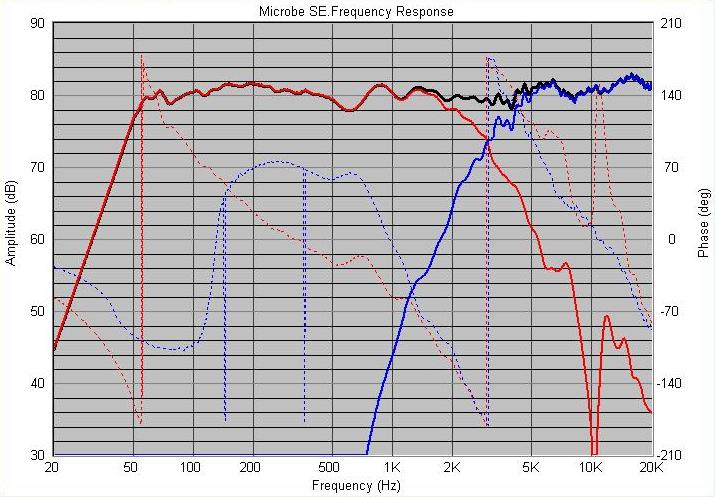 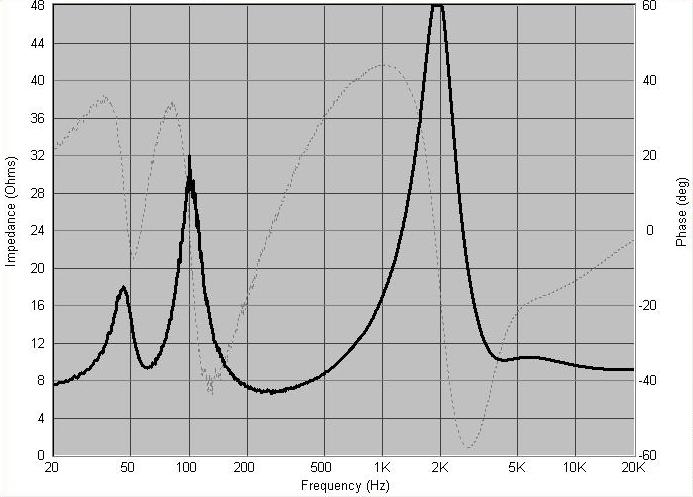
Microbe SE vs. MicrobeBelow is an interactive plot that allows you to see the responses of the Microbe SE and original Microbe at various listening angles. As you can see when comparing the two versions they are very similar with the main difference being less of a dip in the 2-3kHz region for the Microbe SE. The Microbe SE is also a bit smoother off axis but the tweeter dispersion is very similar between the two designs. Overall, the Microbe SE is the flatter of the two designs which should imply that it will have a more neutral sound.
Listening ImpressionsI'll start by saying that the Microbe SE has a very appealing sound that defies its size, like the Microbe, but has added midrange detail giving it a more analytical and neutral sound than it's predecessor. However, even though the upper midrange presence is stronger, the sound is still smooth and a bit on the warm side in the midrange. That 200 Hz peak followed by a 600 Hz dip in the response does give the midrange a certain smooth character and enhances the musicality of the speaker while reducing listening fatigue. This response shape helps to compensate for the small size of the speaker and give it a larger sound. Below 200 Hz the sound starts to lose a little bit of definition but this is the range where the distortion of the small 5" RS125 driver begins to increase however the sound in this region isn't offensive at all. Like the original Microbe the bass is surprisingly deep but the sacrifice is low sensitivity.The Seas 22TAF/G tweeter is an excellent tweeter at its price. It has a very flat response when the baffle diffraction problems are out of the picture. It provides a clean, detailed, analytical sound that is smooth at the same time. It does have certain characteristics common to metal domes that give it a clarity that is appealing. Compared to the fabric dome tweeter in the original Microbe, the 22TAF seems to allow you to hear more of the fundamental tones of a ride cymbal while the fabric dome seems to accentuate more of the "splashy" harmonics. The same applies to the claritiy of tambourines, triangles and bells. I suppose the lower harmonic distortion of the 22TAF/G might have a little to do with this. Overall it is a great little tweeter. In comparing the Microbe SE to the Microbe the main noticeable differences are the midrange definition and the soundstage depth. With a little more support in the 2-3 kHz region the 22TAF/G provides a more neutral sounding midrange with a little more edge and detail. This stronger upper midrange presence changes the soundstage characteristics by moving the midrange forward in the soundstage. This produces a flatter soundstage in this region but also improves the imaging. The soundstage still has plenty of depth but the midrange is more focused and forward. The tweeters do have a different character but both sound quite good. The spatial presentation of the top end of the response with the Tang Band T25-1166S in the original Microbe has a little bit more three-dimensionality to it but the difference is subtle. My friend commented that it sounded like there was a plant placed next to the speaker reflecting the sound and spreading the soundstage in that region. Overall, the Microbe has a more relaxed sound while the Microbe SE sounds more analytical which can make it a bit more fatiguing over time but not harsh at all. So which one is better? It really depends on your preferences as well as the type of music that you listen to. I've found that the original Microbes sound a bit more musical and smooth and really sound great with rock music. The Microbe SE is more neutral and analytical and sound great with jazz and classical as well as well recorded rock recordings (Dire Straits - Brothers In Arms comes to mind). The original Microbes are more forgiving with poorer material but the SE version can be enjoyable as well, just slightly more fatiguing over time. What really matters is the type of sound you are looking for and now I think there are two great options with the Microbe and Microbe SE designs. To sum it up, the Microbe is more musical and the Microbe SE is more analytical. |
